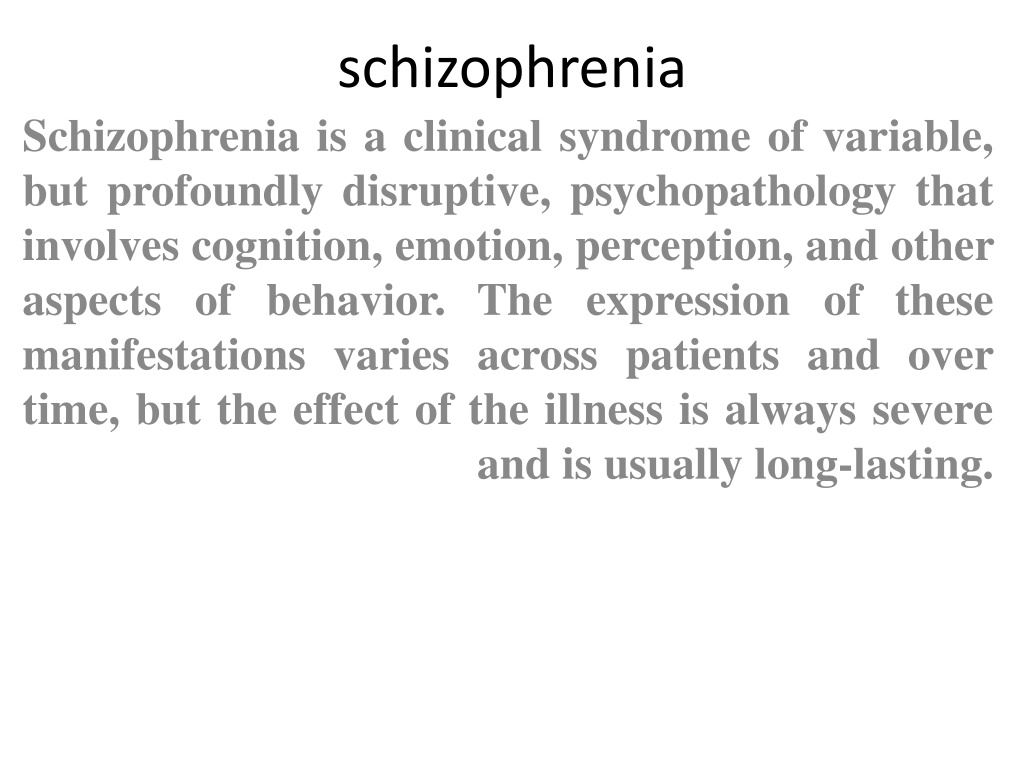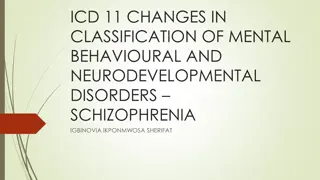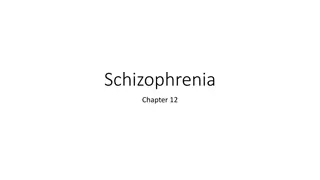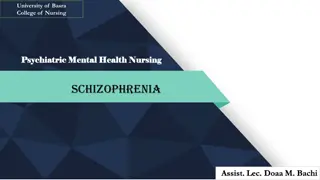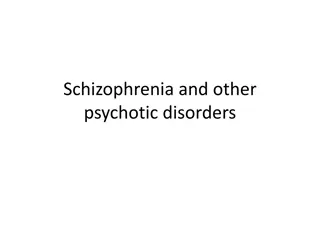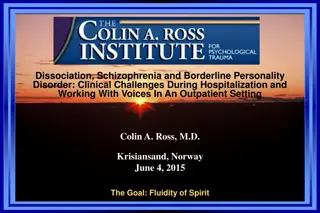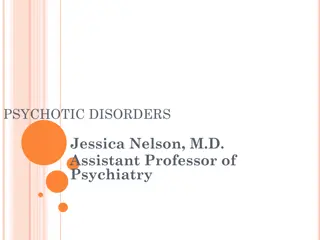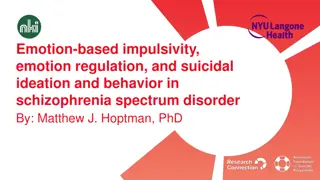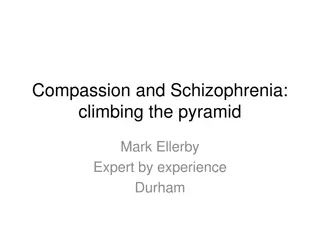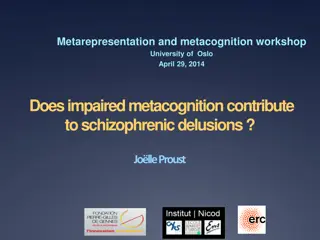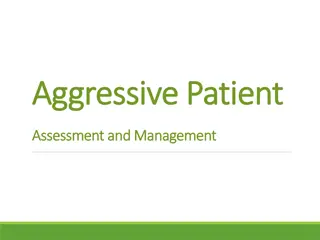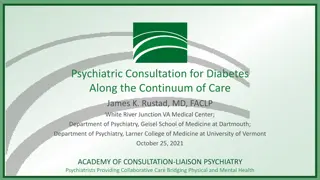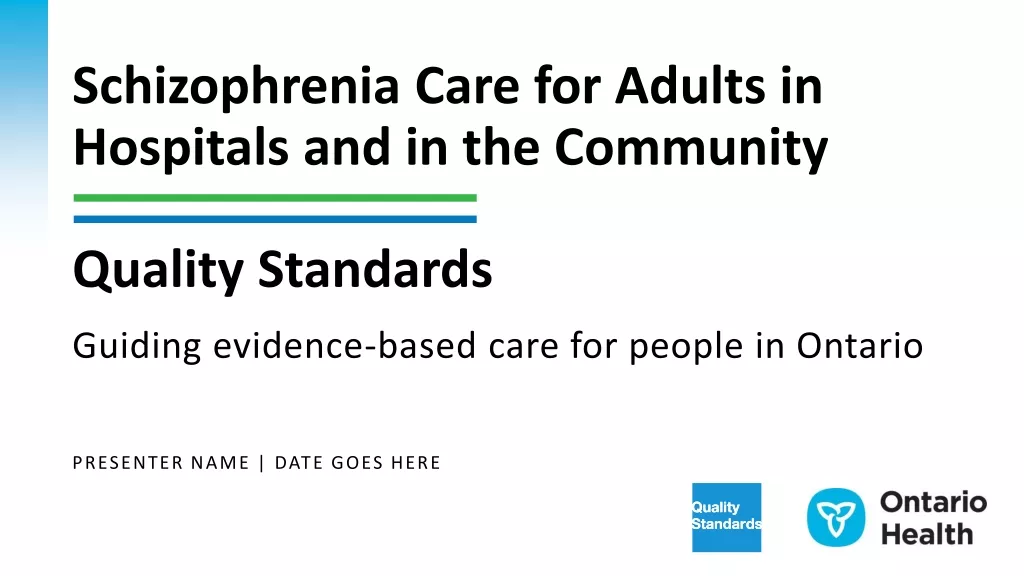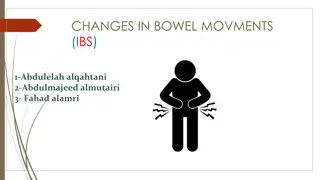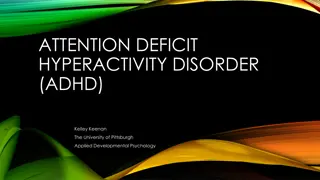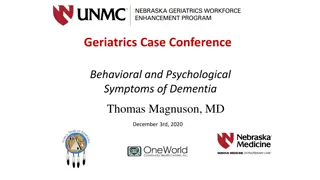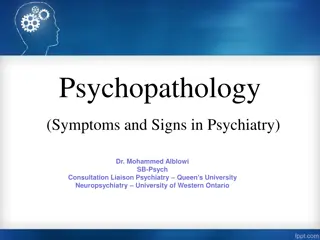Understanding Schizophrenia: Symptoms and Impact
Schizophrenia is a complex mental disorder characterized by disruptions in cognition, emotion, perception, and behavior. It manifests differently in individuals, with symptoms ranging from hallucinations and delusions to social withdrawal and blunted emotions. The illness can have severe and long-lasting effects, impacting both personal and social functioning. Early detection and appropriate treatment are essential to manage the symptoms effectively.
Download Presentation

Please find below an Image/Link to download the presentation.
The content on the website is provided AS IS for your information and personal use only. It may not be sold, licensed, or shared on other websites without obtaining consent from the author. Download presentation by click this link. If you encounter any issues during the download, it is possible that the publisher has removed the file from their server.
E N D
Presentation Transcript
schizophrenia Schizophrenia is a clinical syndrome of variable, but profoundly disruptive, psychopathology that involves cognition, emotion, perception, and other aspects of behavior. The expression of these manifestations varies across patients and over time, but the effect of the illness is always severe and is usually long-lasting.
symptoms Schizophrenia is the most common psychotic illness and characterised by two sets of symptoms; symptoms present during the acute phase; and those present when the illness is well established (chronic). Symptoms of the acute phase (positive symptoms) include hallucinations, delusions, disturbance of thinking, and perplexity (muddled, wondering, uncertainty, vagueness). Chronic symptoms develop insidiously and are more damaging to performance and social functioning. Chronic symptoms include loss of social drive (loss of volition, abulia), blunted emotions and affect, odd behaviour, and apathy (negative symptoms).
Schizophrenia is a leading worldwide public health problem that exacts enormous personal and economic costs. Schizophrenia affects just less than 1 percent of the world s population. The incidence is equal in men and women but the mean age of onset is earlier in men. The lifetime risk of developing schizophrenia is probably between 7.0 and 13.0 per 1000. Using similar diagnostic criteria, WHO studies showed similar prevalence in different countries.
In the acute phase (syndrome), the patient feels unjustly treated (persecuted), not understood, misunderstood, and usually offers no explanation to what he is going through. He becomes suspicious and withdraws mentally and physically from people around him and absorbed and preoccupied with his own thoughts. Mood fluctuates between anger, irritability, anxiety, and depression. Affect may become blunted or inappropriate (incongruous) to the situation. The patient may giggle or laugh for no apparent reason, probably responding to his own thoughts or hallucinations. Thought become muddled and difficult to convey to others because of vagueness (circumstantial, tangential), poor connection to each other (loose association), or muddled (incoherent). Auditory hallucinations present as single wards, phrases, or conversation, and sometimes as noises or music.
The voices may be of people known to the patient, belong to strangers, of males or females, or of one or more persons. Voices may directly address the patient (your are a bastard, homosexual), talk about him in the third person (he is a bastard, homosexual), comment on his actions and behaviour, (running commentary), or give him commands (do this, do not do that). The voices are initially distressing, but they may become familiar and ignored by the patient. Other types of hallucinations as visual, tactile, somatic, olfactory, and gustatory (taste) are less frequent.
Although persecutory delusions are common in schizophrenia, they are not diagnostic because they are also present in other psychotic disorders. Delusions of control (by outside power, person, police), delusions of reference (personalisation of events, TV programmes, news), and delusions about possession of withdrawal, insertion, and broadcast) are less common but are schizophrenia. Culture, traditions, and religious beliefs flavour the contents and context of the delusions and hallucinations. thoughts (thoughts more diagnostic of
Cognitive functions of memory, intelligence, and orientation remain intact. Judgement and reasoning in matters not incorporated by the delusions are intact. However, the ability to interpret proverbs and extract concepts from general themes (abstract thinking) may become impaired. The patient interprets ideas and images literally and unable to appreciate the hidden meaning behind them (concrete thinking). Insight is most often impaired or lost. The chronic phase (syndrome) is characterised by the presence of negative symptoms as well as some of the positive symptoms. The patient gradually becomes reluctant to go to school or work and withdraws from social activities. Performance and functioning deteriorate. More time is spent at home and in bed virtually doing nothing and signs of self- neglect become evident.
Peculiar postures and movements as stereotype, mannerism, catatonia, and waxy flexibility may occur. The patient may remain immobile, mute, and unresponsive (catatonic stupor) for hours or days without food and drink. The patient is conscious, and after recovery, some patients report that they aware of the surrounding. Sometimes catatonic stupor changes to unprovoked and uncontrolled motor activity and aggression (catatonic excitement).
Delusions, in contrast to the acute phase, cause little or no emotional distress (blunted or flat affect). In both the acute and the chronic syndromes, the constellation of symptoms and their severity may vary in different patients. Symptoms of thought disorder are prominent in young patients, whereas paranoid symptoms are prominent in older patients. Depressive symptoms may be present early at onset of the disease, during its course, or after recovery. It is not clear whether the depressive symptoms are part of the disease, side effects of the drugs, or a reaction to recovery and regain of insight. A rare and unexplained phenomenon of excessive water drinking that may lead to intoxication may occur in schizophrenia.
Schneiders first rank symptoms (SFRS) are incorporated in the ICD-10 and DSM1V diagnostic criteria of schizophrenia. These symptoms include hearing own thoughts spoken loud; third-person hallucinations; hallucinations in the form of commentary; somatic hallucinations; thoughts withdrawal or insertion; thoughts broadcasting; delusional perceptions; and feelings,impulses and actions are experienced as made by or influenced by external agents. Some SFRS are present in some patients with mania.
Subtypes of schizophrenia include hebephrenic, catatonic, paranoid, and simple schizophrenia. Hebephrenic(disorganized) type shows silly and childish behaviour with affective symptoms, thought disorder, and fragmented delusions and hallucinations. Catatonic symptoms are prominent in the catatonic type. Paranoid schizophrenia is characterised by well-organised and elaborate delusions (systematised, there is a theme) and a relatively normal affect and thought process. Simple schizophrenia develops insidiously and presents as gradual deterioration of functioning in school, work, and socially. Positive symptoms are absent.
AETIOLOGY: The aetiology of schizophrenia is not well understood, but the available evidence indicates a strong genetic predisposition. The average lifetime risk is about 5 percent among first-degree relatives of schizophrenics compared with 0.2-0.6 percent among first-degree relatives of control. Family studies showed that 16.2 percent of children of schizophrenic mothers developed schizophrenia compared with 1.9 per cent among controls. There is also excess (21.3%) of children with schizoid, schizotypal, and paranoid personality disorders than among controls (5%). Twin studies showed higher concordance for schizophrenia in monozygotic twins (about 50%) than in dizygotic twins (about 10%).
The offspring of the healthy twin carry the same degree of risk to develop schizophrenia as the affected twin. Adoption studies showed that there is excess of schizophrenia, schizoaffective psychosis, and schizotypal personality disorders in the biological relatives of schizophrenic probands. Hebephrenic and catatonic schizophrenia carry a higher genetic loading than paranoid type. There is no agreement about the mode of inheritance of schizophrenia and three theories are proposed. The monogenic theory suggests a single gene of variable penetrance to account for the variable degree of risk in the relatives of the proband (first-degree, second-degree).
The polygenic theory suggests that schizophrenia is the result of the cumulative effect of several genes and is expressed when a certain threshold of susceptibility is exceeded. Whereas the monogenic and polygenic theories suggest that schizophrenia is a single disease, the heterogenic theory suggests that schizophrenia is a group of disorders. These disorders have different genetic make-up and this may account for the difference in the expression of this disease. Molecular genetic studies so far did not locate a gene or genes linked to schizophrenia. Gross examination of the brain of schizophrenics showed smaller weight, enlarged lateral ventricles, and reduced volume of the hippocampus and parahippocampal gyrus.
These changes tend to be more evident on the left side of the brain. Histopathological examination showed disturbance of cytoarchitecture in the hippocampus, frontal cortex, cingulate gyrus, and entorhinal cortex. MRI studies showed reduced temporal lobe volume and abnormalities in the frontal lobe, basal ganglia, and thalamus. Enlargement of the lateral ventricles is associated with male sex, early age of onset, neuropsychological impairment, and poor response to treatment. MRI changes are associated with poor response to treatment and neuropsychological impairment.
Studies showed that schizophrenic patients often have some soft neurological signs. Soft neurological signs are not associated with neurological deficit and include minor changes in the EEG, balance, eye-tracking movements, tendon proprioception, and graphaesthesia. Studies of brain functions with PET and SPET showed reduced blood flow in the frontal and prefrontal cortex (hypofrontality) during tasks (Wisconsin Card sorting Test) that require participation reflexes, stereognosis, of these areas. A study of monozygotic twins discordant for schizophrenia showed that affected twins had reduced prefrontal blood flow and reduced hippocampal volume. These findings suggest that symptoms of schizophrenia are associated with abnormal function of the temporal and frontal lobes.
It is suggested that disorders of attention and conscious awareness, or the breakdown of internal representation of mental events predispose to the development of psychotic symptoms. It is also suggested that symptoms of frontal lobe lesions resemble the negative symptoms of schizophrenia.
BIOCHEMICAL CHANGES IN SCHIOPHRENIA: The dopamine hypothesis suggests that schizophrenia result from excessive activity at dopamine synapses. This hypothesis is based on the following observations. (1)Amphetamine and cocaine (psychostumulants) abuse may produce a psychotic disorder indistinguishable from schizophrenia and worsen or cause relapse of the disease. (2) The therapeutic effect of antipsychotic drugs is by blocking postsynaptic dopamine receptors. Amphetamine and cocaine release monoamines, particularly dopamine and noradrenaline, at the synapses in the brain and increase their turnover. The precursor of dopamine, L-dopa and the directly acting dopamine agonist bromocriptine may cause psychosis in patients taking these drugs. However, these observations do not necessarily prove that the abnormality in schizophrenia is primarily in the dopamine transmission system.
The therapeutic potency of antipsychotic drugs correlate with their affinity to bind to and block dopamine D2receptors. These drugs are also effective in mania. Post-mortem biochemical studies of brains of schizophrenic patients revealed increased dopamine receptor density in the caudate nucleus, putamen, and nucleus accumbens. There is also increased concentration of dopamine in the amygdala of the left hemisphere and caudate nucleus. Treatment with antipsychotic drugs may increase the density of dopamine receptors. Recent studies examined the role of the excitatory amino acid neurotransmitter glutamate. Glutamate has extensive interactions with dopamine pathways. Phencyclidine (angle dust) and ketamine are glutamate receptor antagonists and produce delusions and hallucinations as well as negative symptoms.
ENVIRONEMENTAL AETIOLOGICAL FACTORS: Studies of birth complications in schizophrenic and controls are in inconsistent. An older study found more obstetric complications in schizophrenics than in controls, but a recent study did not confirm this finding. However, in the presence of family history of schizophrenia, obstetric complications may increase the risk of developing schizophrenia and lateral ventricle enlargement. Studies of the season of birth showed that more schizophrenics were born in winter than in summer. Viral infections are more frequent in winter months and it is suggested that prenatal exposure to infection increase the incidence of schizophrenia. This suggestion has not been confirmed. The association between personality disorders and schizophrenia is not clear, but studies suggested that abnormal premorbid personality is more common in schizophrenics. The incidence of schizophrenia is about equal in both sexes. However, males have earlier age of onset, poor premorbid personality, more frequent severe relapses, and more evidence of structural brain abnormality. Schizophrenic women have later-onset, more affective and paranoid symptoms, and better prognosis.
FAMILY THEORIES: These propose that schizophrenia is the result of abnormal relationship (deviant role relationship) or abnormal communication (disordered communication) in the family. Two family patterns are described; marital skew where one parent was dominant and the other submissive; and marital schism where parents maintained contrary view and the child is caught in the middle. Abnormal communication between the child and the parents sends contradictory signals (love and rejection, double bind) to the child who learns to respond ambiguously. Disordered social communication (vague, lose, indefinite, fragmented) also occurred between the parents and affected the child.
SOCIAL FACTORS: Culture is unlikely to play a role in the aetiology of schizophrenia because the incidence rates of the disease are similar in countries with different cultures. However, cultural factors (religion, traditions, custom) may influence the contents of delusions, hallucinations, and thought disorder. The higher incidence and prevalence of schizophrenia in lower social class is probably the result of the disease rather than the cause of it. The effects of the disease on schooling and occupation lower social status. Schizophrenics are over-represented in inner-city areas, but whether this is because of social and occupational decline (drifting), or because of environmental etiological factors is not clear. Studies showed that the incidence of schizophrenia is higher among migrants compared to the incidence in their native country and in the native population of the host country.
The roles of premorbid personality, stress of migration, social isolation, discrimination are not clear. Psychological life stresses appear to increase the risk of developing first episodes and precipitating relapses of schizophrenia. Severity of symptoms of chronic patients correlated with stressful life event. In summary, the aetiology of schizophrenia is not clear, but the available knowledge favours a strong genetic predisposition with contribution from environmental factors. and racial
DIFFERENTIAL DIAGNOSIS: The positive symptoms are the hallmark of the acute phase of schizophrenia and are usually present with the negative symptoms in the chronic phase. For the purpose of diagnosis, these symptoms should be present with intact consciousness and clinically normal cognitive functions. Other disorders that may present with positive symptoms are organic and mood disorders. Acute brain syndromes as herpes simplex encephalitis, delirium, and drugs intoxication (amphetamine, LSD) often present with delusions and hallucinations. Complex partial seizure may present with psychotic symptoms. Diffuse brain diseases as dementia, systemic lupus erythematosus, general paralysis of insane, and AIDS may present with psychotic symptoms
. Alcohol abuse may be associated with psychotic symptoms during intoxication, withdrawal, and in korsakov-Wernicke syndrome. Organic brain disorders are often associated with cognitive impairment, clouding of consciousness, and abnormal neurological findings. Mood disorders with psychotic symptoms are differentiated from schizophrenia by the dominance of affective symptoms, delusions and hallucinations confirm guilt, worthlessness or grandiosity, and the contents are accepted by the patient. Patients with schizophrenia reject the contents of their delusions and hallucinations. Schizophrenia with dominant negative symptoms may be confused with personality disorders.
TREATMENT OF SCHIZOPHRENIA ANTISPYCHOTIC DRUGS: The antipsychotic drugs are the backbone of any treatment regime for schizophrenia. Regimes that include rehabilitation and social support are only helpful after the florid symptoms have subsided. Interpretative psychotherapy and emotionally and socially demanding programmes are inappropriate and worsen the symptoms. Most antipsychotic drugs are lipophilic (lipid-soluble) and easily absorbed from the gut to reach liver through the portal circulation. They undergo first-pass metabolism (before reaching the blood circulation) which reduces the amount of the parent drug in the blood
Antipsychotic drugs block dopaminergic receptors (D receptor antagonists), and some of which have selective affinity to a particular type of receptors. It is noted that their therapeutic potency is related to their affinity to block D2 receptors. D2type dopamine receptors are also found presynaptically on dopamine neurones. These act as autoreceptors and inhibit the release of dopamine (negative feedback). Antipsychotic drugs also block D2 autoreceptors. Antipsychotic drugs also block noradrenergic and cholinergic receptors causing autonomic nervous system side effects.
Dopaminergic receptors blockade in the basal ganglia produces extrapyramidal side effects. Antipsychotic drugs include phenothiazines, thioxanthines, butyrophenones, substituted benzamides, butylpiperidines, and the atypical antipsychotics. There are three phenothiazine groups of drugs, which vary in their sedating and extrapyramidal side effects. Aminoalkyl compounds represented by chlorpromazine are the most sedating and have moderate extrapyramidal and marked anticholinergic side effects. Their effective dosage is the highest in the group. Piperidine compounds represented by thioridazine are moderately sedating and have marked anticholinergic and weaker extrapyramidal side effects.
Their effective dosage is moderate. Piperazine compounds represented by trifluoperazine are the least sedating and have the weakest anticholinergic and strongest extrapyramidal side effects. Their effective dose is small. The thioxanthines are represented by flupenthixole and clopenthixole and are similar in structure and properties to the phenothiazines. The butyrophenones represented by haloperidol are potent antipsychotic with marked extrapyramidal and very little sedating side effects. The butylpiperidines represented by pimozide are structurally related to the butyrophenones but have longer half-life to be given once daily. The substituted benzamides represented by sulpride and remoxipride are highly selective D2 receptors antagonist. They are less likely to cause extrapyramidal disorders and have no sedating and anticholinergic side effects.
The therapeutic effects and the extrapyramidal side effects of the antipsychotic drugs are presumably related to their antidopaminergic properties. The atypical antipsychotics are so called because although they block D2dopaminergic receptors are less likely to cause extrapyramidal side effects. Atypical antipsychotics currently include amisulpride, clozapine, olanzapine, quetiapine, respiridone, and sertindole. Their main therapeutic advantage is their presumed efficacy on the negative as well as the positive symptoms of schizophrenia. The relapse rate is lower in patients on antipsychotic medications. Depot preparations (long acting) as fluphenazine decanoate and haloperidol decanoate are used when compliance to take the medication is a problem. Intramuscular injection of chlorpromazine, droperidol, or haloperidol is used to quickly sedate a disturbed patient.
The extrapyramidal side effects include parkinsonian syndrome, acute dystonia, akathisia, and tardive dyskinesia (TD). Parkinsonian syndrome is the most common side effect and is clinically similar to Parkinson disease. It presents as bradykinesia (reduced mobility) or akinesia (no mobility), slowness of movements, rigidity, and tremor. Symptoms appear a few months after starting treatment. It responds to dose reduction and anticholinergic antiparkinsonian drugs (benzhexol, procyclidine). Acute dystonia (abnormal posture of parts of the body) is more common in young males, and appears early in treatment and sometimes after a single dose. It may involve the tongue (painful protrusion), twisting and retraction of the neck and head (torticollis), upward and sideways rolling of the eye balls (oculogyric crisis), or twisting and arching of the trunk (opisthotonus). Acute dystonia responds promptly to intravenous anticholinergic antiparkinsonian drugs and antihistamines
Akathisia (motor restlessness, fidgeting) is an uncontrolled urge to change body-posture and position. It may appear early or late after starting treatment and may respond to dose reduction and antiparkinsonian drugs. Tardive (late to develop) dyskinesia is more common among women and elderly patients and usually appear after long-term treatment with antipsychotic drugs. . Risk factors for the development of TD include older age, diffuse brain damage, and the presence of affective disorder. It is suggested that after long-term blockade of the dopaminergic receptors, these become supersensitive to the effect of dopamine causing TD. TD may present as chewing and sucking movements, facial grimacing, and choreoathetosis. TD may worsen or improve after withdrawal of the antipsychotic drugs. Treatment with anticholinergic antiparkinsonian drugs (benzhexol), and dopamine agonist drugs (apomorphine, bromocriptine, L- dopa) may aggravate TD. Well-established TD is resistant to treatment. Drugs used for the treatment of TD include lithium, carbamazepine, sodium valproate,Atypical antipsychotic, tetrabenazine (depletes dopamine), and - blockers
Most patients taking antipsychotic drugs either have tolerable or no extrapyramidal side effects and the routine prophylactic use of antiparkinsonian drugs is not justified. Other side effects of antipsychotics include anti-adrenergic symptoms (postural hypotension, tachycardia, nasal congestion, delayed or no ejaculation), and anticholinergic symptoms (dry mouth, reduced sweating, constipation, blurred vision). Patients with hypertrophy of the prostate may have urinary hesitation or retention because of the anticholinergic side-effects (poor bladder contraction). Uncommon side effects include hypothermia, cardiac arrythmias, galactorrhoea, seizures in epileptic patients, photosensitivity and pigments accumulation (skin, eye lens, cornea), retinal degeneration, blood dyscrasias, and cholystatic jaundice
A rare, but serious complication of antipsychotic treatment, is the neuroleptic malignant syndrome (NMS). NMS usually occur during the first 10 days of treatment and the onset is usually rapid (1to 3 days). The clinical picture includes hyperpyrexia, and muscular, mental, and autonomic symptoms. Generalised muscular rigidity may involve the muscles of swallowing causing dysphagia, and the intercostal muscles causing dyspnoea. Muscular rigidity may cause muscle damage with raised creatine phosphokinase plasma level and myoglobinurea. Severe cases may present with impaired consciousness, stupor, or akinetic mutism. The patient is aware of the surroundings but does not communicate or moves. Patients who recover report that they attempted to speak but were unable to vocalise
Milder cases may stutter. Autonomic disturbance cause excessive sweating and salivation, unstable blood pressure, tachycardia, and urinary incontinence. Complications include cardiovascular failure, renal failure, pneumonia, and thromboembolism. NMS has a course of 1 to 2 weeks and a mortality rate of about 10 percent. Patients who survive have complete recovery. Management includes stopping the antipsychotic drugs, measures to lower body temperature, and maintenance of fluid balance and blood pressure. Diazepam and dantrolene are given to reduce muscular rigidity. Combined treatment with lithium and antipsychotic drugs may predispose the patient to develop NMS. There are reports of unexplained sudden death of patients taking antipsychotic drugs.
COURSE AND PROGNOSIS: Schizophrenia is a serious mental illness often associated with occupational and social decline. Earlier long-term follow up studies (M. Bleuler, Ciompi, Huber) showed that about one third of patients had good or fair recovery and social adjustment. Full recovery usually occurred in the first two years of the illness and seldom after five years. Patients with first admission generally did better and symptoms became less severe during the later years of life. The clinical features of relapses are usually similar to those of the first attack. Some recent studies showed better outcome (Johnston), whereas others showed similar (Tsoi and Wong) or worse outcome (Carone), but the general trend agrees with earlier studies. Severe disability occurred in about 20 percent of patients. Schizophrenia carries a substantially higher mortality rate than the general population both from natural causes and suicide. Long-term follow up studies show that up to 10 percent of schizophrenics die by suicide
Some of the factors that may predict good prognosis include sudden onset, positive symptoms, and older age at onset, significant affective symptoms, paranoid type illness, and good social and occupational premorbid adjustment. The opposite of these factors may predict poor outcome. Studies in developed and developing countries showed that the outcome is better in the latter where complete recovery is more likely. Studies of the effects of the environment on the symptoms showed that under-stimulating environment was associated with worsening negative symptoms and over-stimulating and demanding environment can precipitate positive symptoms and lead to relapse. Schizophrenics have limited resources to cope with excessive social demands and emotional involvement. The term high expressed emotions includes critical comments, expressed hostility, and emotional over-involvement. Studies had show that relapse rate is higher in families where relatives show high expressed emotions.
CLIENT AND FAMILY TEACHING: SCHIZOPHRENIA How to manage illness and prevent relapse Importance of maintaining prescribed medication regimen and regular follow-up Avoiding alcohol and other drugs Self-care and proper nutrition Teaching social skills through education, role modeling, and practice Counseling and education of family/significant others about the biologic causes and clinical course of schizophrenia and the need for ongoing support Importance of maintaining contact with community and participating in supportive organizations and care
